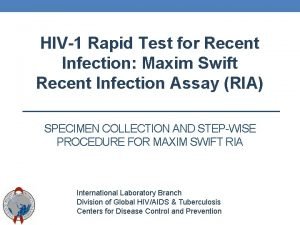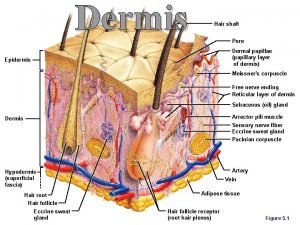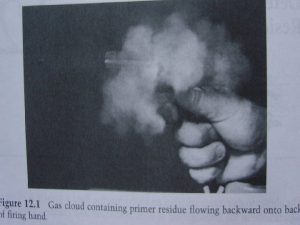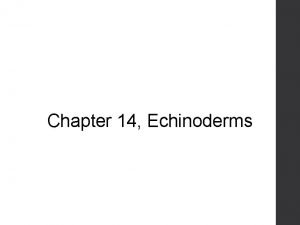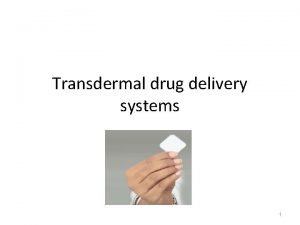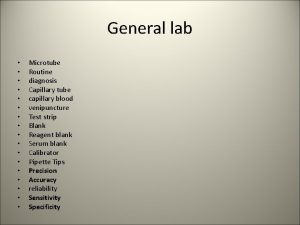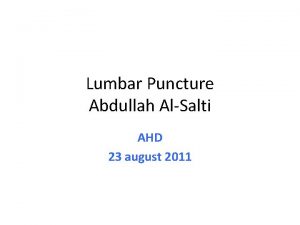Dermal Capillary Puncture Chapter 10 Mc GrawHill Education




























- Slides: 28

Dermal (Capillary) Puncture Chapter 10 ©Mc. Graw-Hill Education. All rights reserved. Authorized only for instructor use in the classroom. No reproduction or further distribution permitted without the prior written consent of Mc. Graw-Hill Education.

Learning Outcomes 10. 1 Explain why dermal (capillary) puncture is used instead of routine venipuncture for some patients. 10. 2 Select an appropriate site for dermal (capillary) puncture and identify the equipment needed. 10. 3 Carry out the procedure for performing a dermal (capillary) puncture. 10. 4 Apply the procedure for collecting a dermal (capillary) specimen. ©Mc. Graw-Hill Education.

NAACLS Competencies 1 5. 00 Demonstrate knowledge of collection equipment, various types of additives used, special precautions necessary, and substances that can interfere in clinical analysis of blood constituents. 5. 5 List and select the types of equipment needed to collect blood by venipuncture and capillary (dermal) puncture. 5. 6 Identify special precautions necessary during blood collections by venipuncture and capillary (dermal) puncture. 6. 00 Follow standard operating procedures to collect specimens. 6. 1 Identify potential sites for venipuncture and capillary (dermal) puncture. ©Mc. Graw-Hill Education.

NAACLS Competencies 2 6. 2 Differentiate between sterile and antiseptic techniques. 6. 3 Describe and demonstrate the steps in the preparation of a puncture site. 6. 4 List the effects of tourniquet, hand squeezing, and heating pads on specimens collected by venipuncture and capillary (dermal) puncture. 6. 6 Describe and perform correct procedure for capillary (dermal) collection methods. 6. 7 Describe the limitations and precautions of alternate collection sites for venipuncture and capillary (dermal) puncture. ©Mc. Graw-Hill Education.

NAACLS Competencies 32 6. 10 List the steps necessary to perform a venipuncture and a capillary (dermal) puncture in order. 6. 11 Demonstrate a successful venipuncture following standard operating procedures. ©Mc. Graw-Hill Education.

Key Terms Calcaneus Interstitial fluid Osteomyelitis Palmar Plantar ©Mc. Graw-Hill Education.

Dermal (Capillary) Puncture Learning Outcome 10. 1 22

Introduction to Dermal (Capillary) Puncture Preferred method for young patients • Infants • Very small children May also be used for other patients • Obese • Elderly • Severely burned ©Mc. Graw-Hill Education.

Preparing for Dermal (Capillary) Puncture Learning Outcome 10. 2

Check Your Competency 10 -1: Dermal Puncture Preparation 1. Acquire and examine the requisition slip. 2. Greet and identify the patient. 3. Explain the procedure. 4. Verify any dietary restrictions. 5. Wash your hands. 6. Put on gloves. ©Mc. Graw-Hill Education.

Selecting a Dermal (Capillary) Puncture Site ©Mc. Graw-Hill Education. Copyright © Mc. Graw-Hill Education

Assembling Dermal (Capillary) Puncture Equipment ©Mc. Graw-Hill Education/Sandra Mesrine, photographer

Performing a Dermal (Capillary) Puncture Learning Outcome 10. 3

Planning the Puncture • Examine the fingers • Choose a finger for the puncture • Plan to cut across the fingerprint ©Mc. Graw-Hill Education. Copyright © Mc. Graw-Hill Education

Performing the Puncture • Clean the site with alcohol • Allow to dry completely • Hold the finger to stretch skin tightly • Puncture the finger ©Mc. Graw-Hill Education. ©Lillian Mundt

Check Your Competency 10 -2: Performing a Dermal (Capillary) Puncture 1. Assemble the equipment, considering the patient and puncture depth. 2. Clean the site with an alcohol pad and allow the site to dry thoroughly. 3. Hold the finger (or heel) with the skin stretched tightly. 4. Use the lancet or puncture device according to the manufacturer’s directions to create the puncture. ©Mc. Graw-Hill Education.

Collecting the Dermal (Capillary) Specimen Learning Outcome 10. 4

Collection Procedure Wipe away first drop Apply steady pressure Collect specimen ©Mc. Graw-Hill Education/Take One Digital Media, photographer

Order of Draw • EDTA (lavender or pink) • Heparin (green or light green) • Sodium fluoride (gray) • Nonadditive (red) or serum separator (gold) ©Mc. Graw-Hill Education.

Check Your Competency 10 -3: Collecting the Dermal (Capillary) Specimen 1 1. After performing the dermal puncture, wipe away the first drop of blood. 2. If using capillary tubes, hold the tube horizontally and touch the end of the tube to the next drop of blood to fill the tube by capillary action. 3. If using microcollection containers, follow the correct order of draw. Allow free-flowing drops of blood to enter the collection device, without milking the finger. 4. If the microcollection container includes an anticoagulant additive, tap the container gently on a hard surface after each drop to mix the blood with the additive. ©Mc. Graw-Hill Education.

Check Your Competency 10 -3: Collecting the Dermal (Capillary) Specimen 2 5. Collect blood to the fill line on the container. Collect a capillary tube to 2/3 to ¾ full. Do not overfill or underfill. 6. Cap the microcollection container or seal the capillary tube. 7. If the container contains an additive, mix by inverting the container according to the manufacturer’s directions. Seal the capillary tube ends. 8. Dispose of the puncture device in the sharps container. 9. Label the microcontainers. 10. Check the puncture site and apply a bandage if appropriate. ©Mc. Graw-Hill Education.

Complications of Dermal Puncture • Infection • Osteochondritis • Osteomyelitis ©Mc. Graw-Hill Education.

Minimum and Maximum Blood Volumes Collecting the correct volume is important • Enough for tests to be performed • Do not exceed maximum allowed for day or over short time Most containers are marked with acceptable minimum and maximum fill levels ©Mc. Graw-Hill Education. ©Lillian Mundt

Example Guidelines for Blood Collection Volumes Body Weight (kg) Body Weight (lb) Maximum allowable volume (m. L) in one blood draw (2. 5% of total blood volume) Total maximum allowable volume (m. L) drawn over 30 days 1 2. 2 2. 5 5 2 4. 4 5 10 3 6 12 4 8. 8 8 16 5 11 10 20 6 13. 2 12 24 7 15. 4 14 28 8 17. 6 16 32 9 19. 8 18 36 10 22 20 40 ©Mc. Graw-Hill Education.

After the Dermal (Capillary) Puncture • Place used lancet in sharps container • Label the microcontainers • Check patient’s finger and apply bandage if necessary • Collect and dispose of supplies appropriately • Thank and dismiss the patient • Remove gloves • Transport specimen to the laboratory ©Mc. Graw-Hill Education.

Chapter Summary 1 • Dermal (capillary) puncture is used for blood collection from infants, small children, and adults in whom veins may be difficult to find, such as elderly patients, obese patients, or severely burned patients. • Dermal puncture procedures include a series of detailed steps that must be performed safely and accurately. • Properly identify patients and prepare them for blood collection by explaining the procedure and positioning them in a supported seated or lying position. • Select an age-appropriate site on the fingers or the heel of the foot. ©Mc. Graw-Hill Education.

Chapter Summary 2 • Equipment needed for dermal puncture is the same as that used for venipuncture with the exception of the puncture device and the collection containers. • Properly cleanse the puncture site using an alcohol prep pad or other appropriate antiseptic; wipe in a circular motion from the center outward. Be sure the site is dry before collecting blood. • It is essential to follow aseptic technique and standard precautions and to collect the specimen in the appropriate microcontainers. ©Mc. Graw-Hill Education.

Chapter Summary 3 • Complications of dermal puncture include infection, osteochondritis, and osteomyelitis. • It is important to draw the correct amount of blood—no less than the minimum and no more than the maximum amount. Drawing less than needed for tests requires an additional puncture; drawing too much may result in exsanguination, especially in infants and small children. • After the puncture is complete, dispose of the contaminated safety lancet, label the microcontainers, check the puncture site, apply a bandage if indicated and appropriate, dispose of used supplies, clean the area, and thank and dismiss the patient. ©Mc. Graw-Hill Education.
 Capillary puncture equipment and procedures
Capillary puncture equipment and procedures Capillary puncture equipment
Capillary puncture equipment Capillary puncture finger
Capillary puncture finger Capillary puncture finger
Capillary puncture finger Grawhill
Grawhill Grawhill
Grawhill Grawhill
Grawhill Grawhill
Grawhill Mc grawhill
Mc grawhill Mc grawhill
Mc grawhill Grawhill
Grawhill Mc grawhill
Mc grawhill Grawhill
Grawhill Chapter 20:1 operating the microscope
Chapter 20:1 operating the microscope Papillary dermal layer
Papillary dermal layer Functions of stem
Functions of stem Dermal tissue types
Dermal tissue types Dermal tissue example
Dermal tissue example Papillae of skin
Papillae of skin What is a paraffin test
What is a paraffin test Dermal tissue types
Dermal tissue types Morfologa
Morfologa Sea urchin diagram
Sea urchin diagram Echinoderms characteristics
Echinoderms characteristics Characteristics of ophiuroidea
Characteristics of ophiuroidea Dermal advancement flap
Dermal advancement flap Dermal zones of jaundice
Dermal zones of jaundice Dermal structure
Dermal structure Factors affecting dermal penetration of drugs
Factors affecting dermal penetration of drugs


